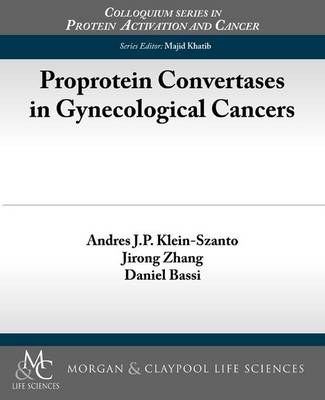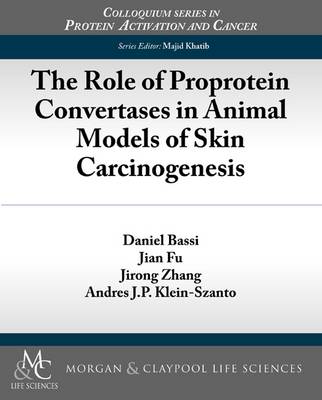Colloquium Series on Protein Activation and Cancer
2 total works
Proprotein Convertases in Gynecological Cancers
by Andres J.P. Klein-Szanto, Jirong Zhang, and Daniel Bassi
Published 15 August 2012
Gynecological cancers include neoplasias of internal female genital organs, mainly ovarian, endometrial and cervical tumors, and cancers of the external female genital structures. Current scientific evidence indicates that both up- and down-regulation of the expression of PCs are part of the multiple changes occurring in these gynecological tumors. Nevertheless, the physiological significance of this puzzling pattern of PC expression remains elusive. The fact that PCs can activate both pro- and anticarcinogenic substrates may indicate that the nature of the overexpressed substrates in certain cancer types could determine the final outcome; i.e., slowing or accelerating cancer development.
The expression of PCs in gynecological cancers and the correlation of this expression with other markers may facilitate preventive and therapeutic interventions in at-risk populations. Several studies single out furin as the main PC overexpressed in ovarian and endometrial cancers. For instance, furin expression has been associated with five-year survival in ovarian cancer, and measurements of furin activity in cells obtained by lavage constitute a non-invasive diagnostic tool for endometrial cancer. The other ubiquitously expressed PCs, PC5, PACE4, and PC7 do not show any changes with respect to normal controls or are decisively silenced, as indicated by studies on PACE4 expression and regulation in both ovarian and endometrial tumors.
PCs activate crucial substrates implicated in the progression of gynecological cancers, including adhesion molecules, metalloproteinases, and viral proteins. In the first place, furin, and possibly the other PCs, process both E- and N-cadherin. Processing of these molecules results in variations of cell adhesiveness. The pattern of expression of N- and especially E-cadherin varies during tumor development, as well as in the stages of either epithelial to mesenchymal or mesenchymal to epithelial transitions. E-cadherin is up-regulated during initial steps in ovarian tumor development, whereas N-cadherin follows a more complex expression pattern. Nevertheless, cadherin processing requires fully functional PC activity, a feature that may be explored for future therapeutics applications. Furthermore, PCs drive the activation of metalloproteinases, especially the membrane-type metalloproteases MMP-14 and MMP-15, and also possibly MMP-9. The activity of these metalloproteases promotes the invasion into the omentum and other peritoneal structures, facilitating the degradation of collagens and other extracellular components. Finally, the role of furin in enabling papilloma virus infection, one of the main etiological factors in the development of exocervical cancer, and possibly vaginal and vulvar carcinoma, cannot be overemphasized.
These experimental evidences suggest that careful targeting of PCs in gynecological cancer may represent a feasible strategy to deter tumor progression.
The expression of PCs in gynecological cancers and the correlation of this expression with other markers may facilitate preventive and therapeutic interventions in at-risk populations. Several studies single out furin as the main PC overexpressed in ovarian and endometrial cancers. For instance, furin expression has been associated with five-year survival in ovarian cancer, and measurements of furin activity in cells obtained by lavage constitute a non-invasive diagnostic tool for endometrial cancer. The other ubiquitously expressed PCs, PC5, PACE4, and PC7 do not show any changes with respect to normal controls or are decisively silenced, as indicated by studies on PACE4 expression and regulation in both ovarian and endometrial tumors.
PCs activate crucial substrates implicated in the progression of gynecological cancers, including adhesion molecules, metalloproteinases, and viral proteins. In the first place, furin, and possibly the other PCs, process both E- and N-cadherin. Processing of these molecules results in variations of cell adhesiveness. The pattern of expression of N- and especially E-cadherin varies during tumor development, as well as in the stages of either epithelial to mesenchymal or mesenchymal to epithelial transitions. E-cadherin is up-regulated during initial steps in ovarian tumor development, whereas N-cadherin follows a more complex expression pattern. Nevertheless, cadherin processing requires fully functional PC activity, a feature that may be explored for future therapeutics applications. Furthermore, PCs drive the activation of metalloproteinases, especially the membrane-type metalloproteases MMP-14 and MMP-15, and also possibly MMP-9. The activity of these metalloproteases promotes the invasion into the omentum and other peritoneal structures, facilitating the degradation of collagens and other extracellular components. Finally, the role of furin in enabling papilloma virus infection, one of the main etiological factors in the development of exocervical cancer, and possibly vaginal and vulvar carcinoma, cannot be overemphasized.
These experimental evidences suggest that careful targeting of PCs in gynecological cancer may represent a feasible strategy to deter tumor progression.
The Role of Proprotein Convertases in Animal Models of Skin Carcinogenesis
by Daniel Bassi, Jian Fu, and Jirong Zhang
Published 30 July 2012
Many proprotein convertases (PC), especially furin and PACE4, are involved in pathological processes such as viral infection, inflammation, hypercholesterolemia, and cancer, and have been postulated as therapeutic targets for some of these diseases. In this chapter, we review mostly our work using animal models of squamous cancers that have been induced by chemical or UV carcinogenesis protocols to highlight the role of PCs in the development and progression of experimental tumors. After demonstrating in wild type mice the role of PACE4 in tumor progression as well as detecting the expression of PACE4 and furin in human non-melanoma skin cancers, we developed transgenic mice that over-express either PACE4 or furin in squamous epithelia, including the epidermis. This was accomplished by targeting the expression of the corresponding PC by using the promoter of the bovine keratin 5. Both K5-PACE4 and K5-Furin transgenic mice showed increased susceptibility to a two-stage carcinogenesis protocol of chemical carcinogenesis. Similar studies conducted in K5-PACE4 mice also showed an increased sensitivity to ultraviolet B radiation carcinogenesis. In most of these experiments, we were able to demonstrate that compared to the control wild type mice, the over-expression of the transgene in the epidermis increased the number of benign and malignant skin tumors and also had an effect on tumor progression as evidenced by the presence of less differentiated tumors and more frequent local and distant metastases in many of the transgenic lines. Interestingly, double transgenic mice in which PACE4 and furin are targeted to the epidermis did not show any additive effect, pointing to a probable in vivo overlap of functions at least in cutaneous tissues.
The tumor-enhancing effects of PACE4 and furin further support their possible role as therapeutic targets. Furthermore, a proof of principle for PC inhibition as a therapeutic tool has been substantiated by an in vivo experiment in which the PC-inhibitor, decanoyl-RVKRchloromethylketone, was topically administrated to the skin of wild type and transgenic mice treated with chemical carcinogenesis protocols, resulting in a significant decrease of tumor development and progression.
The tumor-enhancing effects of PACE4 and furin further support their possible role as therapeutic targets. Furthermore, a proof of principle for PC inhibition as a therapeutic tool has been substantiated by an in vivo experiment in which the PC-inhibitor, decanoyl-RVKRchloromethylketone, was topically administrated to the skin of wild type and transgenic mice treated with chemical carcinogenesis protocols, resulting in a significant decrease of tumor development and progression.

